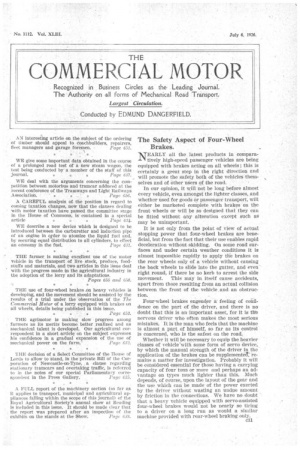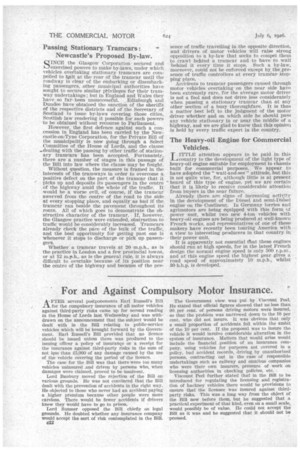COMMERCIAL MOTOR
Page 1

Page 2

If you've noticed an error in this article please click here to report it so we can fix it.
Recognized in Business Circles as the Leading Journal:
The -Authority on all forms of Mechanical Road Transport.
Largest Circulation.
Conducted by EDMUND DANGERFIELD.
The Safety Aspect of Four-Wheel Brakes.
NEARLY all the latest products in con:Taratively high-speed passenger vehicles are being equipped with brakes acting on all wheels ; this is certainly a great step in the right direction and will promote the safety both of the vehicles themselves and of other users of the road.
In our opinion, it will not be long before almost every vehicle, even amongst the lighter classes, and whether used for goods or passenger transPort, will either be marketed complete with brakes On the front wheels or will be so designed that they can be fitted without any alteration except such as may be unimportant.
It is not only from the point of view of actual stopping power that four-wheel brakes are beneficial, but from the fact that their use enables rapid deceleration without skidding. On some road surfaces and under certain weather conditions it is almost impossible rapidly to apply tile brakes on• the rear wheels only of a vehicle without causing the back wheels to slide into the gutter, and even-right round, if there be no kerb to arrest the side movement. This may in itself cause accidents, apart from those resulting from an actual collision between the front of the vehicle, and an obstruction.
Four-wheel brakes engender a' feeling of confidence on the part of the driver, and there is no doubt that this is an important asset, for it is We nervous driver who often makes the most serious mistakes. It is the man who feels that the machine is almost a part of himself, so far as its control is concerned, who is the safest on the road.
Whether it will be necessary to equip the heavier classes of vehicle with some form of Servo device, by which the manual strength of the driver in the application of the brakes can be supplemented,' remains a matter for investigation. Probably it will be considered essential for those having a carrying capacity of four tons or more and perhaps an advantage on types much lighter than this. Much depends, of course, upon the layout of the gear and the use which can be made of the power exerted by the driver without wasting an undue amount by frictionin the connections. We have no doubt that a heavy vehicle equipped with servo-assisted four-wheel brakes would not be nearly so tiring to a driver on a long run as would a similar machine provided with rear-wheel braking only. .
Passing Stationary Tramcars : Newcastle's Proposed By-law.
SINCE the Glasgow Corporation secured and exercised powers to make by-laws, under which vehicles overtaking stationary tramcars are compelled to halt at the rear of the tramcar until the roadway is clear of the embarking or disembarking passengers, other municipal authorities have sought to secure similar privileges for their tramway undertakings ; but in England and Wales they have so far been unsuccessful. .Edinburgh and Dundee have obtained the sanction of the sheriffs of the respective districts and of the Secretary of Scotland to issue by-laws covering those cities, Scottish law rendering it possible for such powers to be obtained without recourse to Parliament.
However, the first defence against such a concession in England has been carried by the Newcastle-on-Tyne Corporation, for the Private Bill of the municipality is now going through a Select Committee of the House of Lords, and the clause —dealing with the passing by other traffic of stationary tramcars has been accepted. Fortunately, there are a number of stages in this passage of the Bill into law where the clause may be fought.
Without question, the measure is framed in the interests of the tramways in order to overcome a positive defect on the part of the tramcar that it picks up and deposits its passengers in the centre of the highway amid the whole of the traffic. Itwould be a worse evil, of course, if the tramcar swerved from the centre of the road to the side at every stopping place, and equally as bad if the tramcar ran beside the pavement throughout its route. All of which goes to demonstrate the obstructive character of the tramcar. If, however, the Glasgow practice were extended, obstruction to traffic would be considerably increased. Tramcars already cheek the pace of the bulk of the traffic, and the best opportunity for getting past one is whenever it stops to discharge or pick up passengers.
Whether, a tramcar travels at 20 m.p.h., as is the practice in London and a few provincial towns, or at 12 m.p.h., as is the general rule, it is always difficult to overtake because of its position near the centre of the highway and because of the pre
sence of traffic travelling in the opposite direction, and drivers of motor vehicles will raise strong opposition to a by-law that seeks to compel them to crawl behind a tramcar and to have to wait behind it every time it stops. Such a by-law, moreover, could not be enforced except by theipresence of traffic controllers at everY tramcarstopping place.
Accidents to tramcar passengers caused through motor vehicles overtaking on the near side have been extremely rare, for the aVerage motor driver is not a fool and does not drive less considerately when passing a stationary tramcar than at any other section of a busy thoroughfare. It is thus a matter best left to the judgment of the motor driver whether and on which side he should pass any vehicle stationary in or near the middle of a highway, and we are glad to know that this opinion is held by every traffic expert in the country.
The Heavy-oil Engine for Commercial Vehicles.
LITTLE attention appears to be paid in. this country to the development of the light type a heavy-oil engine suitable for employment in chassis built for commercial purposes. We appear to have adopted the " wait-and-see " attitude, but this is not quite wise, for, although little is at present heard of this type of engine, yet we are certain that it is_ likely to receive considerable attention from buyers in the near future.
Already there are signs of increasing activity in the development of the Diesel and semi-Dielsel engine on the Continent. In Germany lorries and agrimotors are being equipped with this form, et power -unit, whilst two new 4-ton vehicles with heavy-oil engines are being produced at well-known French works, and representatives of one of these maker have recently been touring America with a view to interesting producers in that country in their power unit. It is apparently not essential that these engines should run at high speeds, for in the latest French design the normal engine speed is -only 500 r.p.m., and at this engine speed the highest gear gives a road speed of approximately 10 m.p.h., whilst 30 b.h.p. is developed.
















































